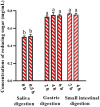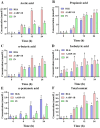Effects of in vitro simulated digestion on the α-glucosidase inhibitory activity, structure, and prebiotic activity of a polysaccharide from Anemarrhena asphodeloides Bunge
- PMID: 40860483
- PMCID: PMC12370768
- DOI: 10.3389/fnut.2025.1603237
Effects of in vitro simulated digestion on the α-glucosidase inhibitory activity, structure, and prebiotic activity of a polysaccharide from Anemarrhena asphodeloides Bunge
Abstract
This study explored the changes in the structure and α-glucosidase inhibitory activity of a non-starch polysaccharide derived from Anemarrhena asphodeloides Bunge, AABP-1B, during digestion in vitro and its effect on host intestinal microbiota. Simulations of digestion in the upper digestive tract showed that the reducing sugar content and molecular weight of AABP-1B changed slightly, though no monosaccharides were detected. AABP-1B was resistant to degradation in the simulated upper gastrointestinal environments, retained strong α-glucosidase inhibitory activity after digestion, which may be related to the lack of structural changes. In in vitro fermentation, AABP-1B enhanced the growth of commensal microorganisms, including Bacteroides, Megasphaera, and Prevotella, while inhibiting the proliferation of pathogenic bacteria, such as Escherichia-Shigella. Fermentation of AABP-1B by gut microbes resulted in a notable increase in short-chain fatty acid contents and a decrease in pH levels. Our findings showed that AABP-1B promotes intestinal health and may serve as a prebiotic in the development of functional food.
Keywords: Anemarrhena asphodeloides Bunge polysaccharide; digestive property; intestinal microbiota; structure; α-glucosidase.
Copyright © 2025 Li, Fang, Lan, Xiao, Zhang, Li, Li and Chen.
Conflict of interest statement
The authors declare that the research was conducted in the absence of any commercial or financial relationships that could be construed as a potential conflict of interest.
Figures










Similar articles
-
Effects of Simulated In Vitro Digestion on the Structural Characteristics, Inhibitory Activity on α-Glucosidase, and Fermentation Behaviours of a Polysaccharide from Anemarrhena asphodeloides Bunge.Nutrients. 2023 Apr 19;15(8):1965. doi: 10.3390/nu15081965. Nutrients. 2023. PMID: 37111183 Free PMC article.
-
In vitro digestion of Atractylodes macrocephala polysaccharide and fermentation of human intestinal flora as affected by bran frying.Int J Biol Macromol. 2025 Aug;320(Pt 2):145913. doi: 10.1016/j.ijbiomac.2025.145913. Epub 2025 Jul 11. Int J Biol Macromol. 2025. PMID: 40653238
-
Prescription of Controlled Substances: Benefits and Risks.2025 Jul 6. In: StatPearls [Internet]. Treasure Island (FL): StatPearls Publishing; 2025 Jan–. 2025 Jul 6. In: StatPearls [Internet]. Treasure Island (FL): StatPearls Publishing; 2025 Jan–. PMID: 30726003 Free Books & Documents.
-
Systematic review of the effects of the intestinal microbiota on selected nutrients and non-nutrients.Eur J Nutr. 2018 Feb;57(1):25-49. doi: 10.1007/s00394-017-1546-4. Epub 2017 Oct 30. Eur J Nutr. 2018. PMID: 29086061 Free PMC article.
-
Herbal and dietary therapies for primary and secondary dysmenorrhoea.Cochrane Database Syst Rev. 2001;(3):CD002124. doi: 10.1002/14651858.CD002124. Cochrane Database Syst Rev. 2001. Update in: Cochrane Database Syst Rev. 2016 Mar 22;3:CD002124. doi: 10.1002/14651858.CD002124.pub2. PMID: 11687013 Updated.
References
-
- Zhao L, Yu J, Liu Y, Liu Y, Zhao Y, Li MY. The major roles of intestinal microbiota and TRAF6/NF-κB signaling pathway in acute intestinal inflammation in mice, and the improvement effect by Hippophae rhamnoides polysaccharide. Int J Biol Macromol. (2025) 296:139710. doi: 10.1016/j.ijbiomac.2025.139710, PMID: - DOI - PubMed
LinkOut - more resources
Full Text Sources

